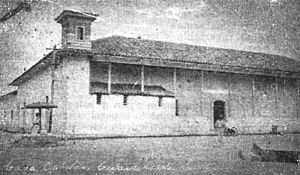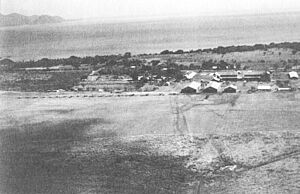Battle of Ocotal facts for kids
Quick facts for kids Battle of Ocotal |
|||||||
|---|---|---|---|---|---|---|---|
| Part of the Occupation of Nicaragua, Banana Wars | |||||||
 Fort Ocotal, held by marines during the occupation of Nicaragua |
|||||||
|
|||||||
| Belligerents | |||||||
| Commanders and leaders | |||||||
| Strength | |||||||
| 37 marines 47 national guard 7 aircraft |
500–600 guerrillas | ||||||
| Casualties and losses | |||||||
| 9 killed & wounded (according to Beckett) 1 killed 5 wounded (according to Nalty) |
40–80 killed (according to Beckett) 56 killed 100 wounded (according to Nalty) |
||||||
The Battle of Ocotal happened in July 1927. It was a major fight during the time when the American military was present in Nicaragua. This period is known as the US occupation of Nicaragua.
A large group of rebels, led by Augusto César Sandino, attacked the town of Ocotal. This town was defended by a small number of US Marines and Nicaraguan National Guards. The rebels suffered heavy losses in the battle. The American and Nicaraguan forces had very few casualties.
Contents
The Battle Begins in Ocotal
By June 1927, the US Marine forces in Ocotal had grown. Captain Gilbert D. Hatfield commanded these forces. His group was meant to patrol the Nueva Segovia area. On July 11, more Nicaraguan National Guards joined them.
When they arrived in Ocotal, Captain Hatfield expected fighting. He had his men build an airstrip. They also set up telegraph service to nearby towns. This helped them communicate quickly.
The US Marines and Nicaraguan guards did not wait long for a fight. On July 15, Captain Hatfield doubled his watch. That same night, Sandino's rebels started entering the town. They came in small groups, two or three men at a time.
First Shots and Rebel Attacks
At 1:15 AM on July 16, a Marine on patrol saw a suspicious man. He fired, and this shot started the battle. With their surprise lost, Sandino ordered his men to attack. They charged the Marines and guards.
Around 4 AM, the rebels made three charges on city hall. During these attacks, Rufo Marin, a rebel leader, was killed. One of these charges lasted for more than four hours. Heavy fighting continued until 8:00 AM. At that time, Sandino demanded that Captain Hatfield surrender. Captain Hatfield refused. He believed his strong positions could stop any more attacks.
Air Support Arrives
Daylight brought two Marine aircraft to the battle. Around 10:00 AM, one plane landed near Ocotal. It was flown by Lieutenant Hayne D. Boyden. He wanted to find out how serious the situation was. The other plane, flown by Gunner Michael Wodarczyk, fired at the enemy.
First Dive Bombing Attack
Soon after, Lieutenant Boyden flew his plane again. He made more firing runs. Then he flew back to Managua. There, he told Major Ross E. Rowell about the battle. Major Rowell quickly formed a group of five planes. These were De Havilland DH-4 biplanes. Each plane had machine guns and four twenty-five pound bombs.
At 2 PM, Rowell's planes arrived over Ocotal. They started dropping bombs on the rebels. The planes flew between 300 and 1,000 feet high. They bombed for about forty-five minutes. Sandino's men had never been attacked by aircraft before. They panicked and began to retreat. This was the first time in history that planes used dive bombing to help ground troops in a battle.
Aftermath of the Battle
After the battle, 56 dead rebels were found. More than 100 rebels were wounded. The US Marines and Nicaraguan National Guards had very few casualties. Some reports say one man was killed and five were wounded. Other reports say a total of nine were killed and wounded.
This battle did not end the fighting. The conflict continued for another five years. However, it was the last time the rebels tried a large, massed attack like this. The use of aircraft forced the rebels to change their fighting methods. This was similar to how British aircraft changed tactics in Somaliland in 1920.
One Marine killed in the battle was Michael Obleski. He was from Roulette, Pennsylvania. He was buried in Ocotal.
Soon after, Major Oliver Floyd's expedition arrived in Ocotal. On July 25, they marched towards San Fernando.
Images for kids
See also
 In Spanish: Batalla de Ocotal para niños
In Spanish: Batalla de Ocotal para niños



